Fourth ventricle
The fourth ventricle is one of the four connected fluid-filled cavities within the human brain. These cavities, known collectively as the ventricular system, consist of the left and right lateral ventricles, the third ventricle, and the fourth ventricle. The fourth ventricle extends from the cerebral aqueduct (aqueduct of Sylvius) to the obex, and is filled with cerebrospinal fluid (CSF).
| Fourth ventricle | |
|---|---|
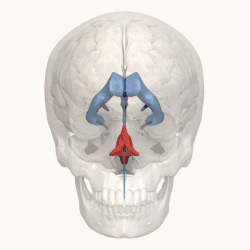 Animation showing the fourth ventricle (in red) in relation to the ventricular system. | |
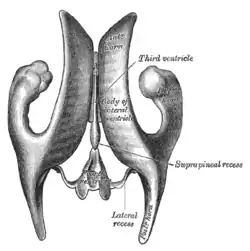 Drawing of a cast of the ventricular cavities, viewed from above. (Fourth ventricle visible at bottom center.) | |
| Details | |
| Identifiers | |
| Latin | ventriculus quartus |
| MeSH | D020546 |
| NeuroNames | 621 |
| NeuroLex ID | birnlex_1256 |
| TA98 | A14.1.05.701 |
| TA2 | 5966 |
| FMA | 78469 |
| Anatomical terms of neuroanatomy | |
The fourth ventricle has a characteristic diamond shape in cross-sections of the human brain. It is located within the pons or in the upper part of the medulla oblongata. CSF entering the fourth ventricle through the cerebral aqueduct can exit to the subarachnoid space of the spinal cord through two lateral apertures and a single, midline median aperture.
Boundaries
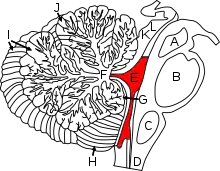
The fourth ventricle has a roof at its upper (posterior) surface and a floor at its lower (anterior) surface, and side walls formed by the cerebellar peduncles (nerve bundles joining the structure on the posterior side of the ventricle to the structures on the anterior side). The caudal tip of the fourth ventricle - where it becomes the central canal - is known as the obex; the obex is also a marker for the level of the foramen magnum of the skull and therefore is a marker for the imaginary dividing line between the medulla and spinal cord
The superior portion of the roof (i.e. of the posterior edge) is a thin lamina - the superior medullary velum - connecting the left and right superior cerebellar peduncles together. The inferior portion of the roof - the inferior medullary velum - has a tricorn cross section, directed caudally and laterally, and is formed by the Cerebellum directly. Near each of the 3 corners of the inferior roof is an opening into the cisterna magna, the caudal opening being the foramen Magendie, while the lateral openings are the foramina of Luschka. The roof rises (i.e. posteriorly) to a peak, known as the fastigium (Latin for "summit");[1] the fastigial nucleus lies immediately above the roof of the fourth ventricle, in the cerebellum.
The floor (i.e. the anterior edge) of the fourth ventricle constitutes the rhomboid fossa, and comprises a number of general features. A sulcus - the median sulcus - extends the length of the ventricle (from the cerebral aqueduct of the midbrain to the central canal of the spinal cord), dividing the floor into right and left halves. Each half is further divided by a further sulcus - the sulcus limitans - along a line parallel to the median sulcus; within the floor, motor neurons are located medially of the sulcus limitans, while sensory neurons are located laterally. The elevation between the median sulcus and sulcus limitans (i.e. the region for motor neurons), is known as the medial eminence, while the lateral region (i.e. that for the sensory neurons) is known as the vestibular area. The sulcus limitans bifurcates at either end - the superior fovea cerebrally, and the inferior fovea caudally.
The pons is located behind the middle and superior portion of the floor. In the superior region of the pons is the locus coeruleus, which due to its concentration of noradrenaline has a sky blue appearance, visible (in a colour closer to teal) through the floor of the ventricle, superiorly to the superior fovea. The internal part of the facial nerve bulges into the ventricle, forming the facial colliculus, in the process of looping around the abducens nucleus within the inferior region of the Pons.
The medulla oblongata is located behind the inferior portion of the floor (and continues caudally of the ventricle). Medullary striae emerge via the median sulcus and run transversely across the floor to become part of the inferior cerebellar peduncle. The hypoglossal nucleus bulges into the floor, creating the hypoglossal trigone, located slightly superiorly to the inferior fovea, within the median eminence. The dorsal nucleus of vagus nerve, within the medulla oblongata, comprises cells that are spindle shaped, also creating a bulge—the vagal trigone—in the region of the floor which overlies them; this is the region inferior of the inferior fovea.
Development
The ventricular system including the fourth ventricle, develops from the central canal of the neural tube. Specifically, the fourth ventricle originates from the portion of the tube that is present in the developing rhombencephalon.[2] During the first trimester of pregnancy the central canal expands into the lateral, third and fourth ventricles, connected by thinner channels.[3] Choroid plexuses appear in the ventricles which produce cerebrospinal fluid. If the flow of fluid is blocked ventricles may become enlarged and cause hydrocephalus.
Clinical significance
The fourth ventricle is a common location of an intracranial ependymomal tumour.
Additional images
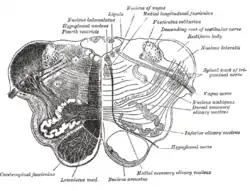 Transverse section of medulla oblongata below the middle of the olive.
Transverse section of medulla oblongata below the middle of the olive. Scheme of roof of fourth ventricle.
Scheme of roof of fourth ventricle. Rhomboid fossa.
Rhomboid fossa. Median sagittal section of brain.
Median sagittal section of brain.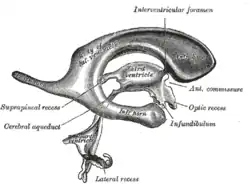 Drawing of a cast of the ventricular cavities, viewed from the side.
Drawing of a cast of the ventricular cavities, viewed from the side. Diagram showing the positions of the three principal subarachnoid cisternæ.
Diagram showing the positions of the three principal subarachnoid cisternæ. Fourth ventricle
Fourth ventricle
References
- Dr. M. A. (Toby) Arnold. "Anatomy Glossary". Archived from the original on 2017-03-01. Retrieved 2015-07-28.
- Le, Tao; Bhushan, Vikas; Vasan, Neil (2010). First Aid for the USMLE Step 1: 2010 20th Anniversary Edition. USA: The McGraw-Hill Companies, Inc. pp. 126. ISBN 978-0-07-163340-6.
- Carlson, Bruce M. (1999). Human Embryology & Developmental Biology. Mosby. pp. 237–238. ISBN 0-8151-1458-3.
External links
- Atlas image: n2a8p1 at the University of Michigan Health System - "Fourth Ventricle, Sagittal Section, Medial View"
- Stained brain slice images which include the "fourth%20ventricle" at the BrainMaps project
- "Anatomy diagram: 13048.000-3". Roche Lexicon - illustrated navigator. Elsevier. Archived from the original on 2012-07-22.